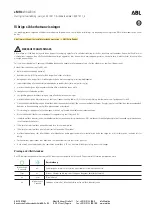
When Should an Air Bag Inflate?
The drivers and passenger’s frontal air bags are
designed to inflate in moderate to severe frontal or
near-frontal crashes. But they are designed to inflate
only if the impact speed is above the system’s designed
“threshold level.”
In addition, your vehicle has “dual stage” frontal air
bags, which adjust the amount of restraint according to
crash severity. For moderate frontal impacts, these
air bags inflate at a level less than full deployment. For
more severe frontal impacts, full deployment occurs.
If the front of your vehicle goes straight into a wall
that does not move or deform, the threshold level
for the reduced deployment is about 12 to 16 mph
(19 to 26 km/h), and the threshold level for a full
deployment is about 18 to 24 mph (29 to 38.5 km/h).
The threshold level can vary, however, with specific
vehicle design, so that it can be somewhat above
or below this range.
If your vehicle strikes something that will move or
deform, such as a parked car, the threshold level will be
higher. The driver’s and passenger’s frontal air bags
are not designed to inflate in rollovers, rear impacts, or
in many side impacts because inflation would not
help the occupant.
Vehicles with dual stage air bags are also equipped with
seat position sensors which enable the sensing
system to monitor the position of the driver’s and
passenger’s seats. The seat position sensor provides
information which is used to determine if the air
bags should deploy at a reduced level or at full
deployment.
The side impact air bags are designed to inflate in
moderate to severe side crashes. A side impact air bag
will inflate if the crash severity is above the system’s
designed “threshold level.” The threshold level can vary
with specific vehicle design. Side impact air bags are
not designed to inflate in frontal or near-frontal impacts,
rollovers or rear impacts, because inflation would not
help the occupant. A side impact air bag will only deploy
on the side of the vehicle that is struck.
In any particular crash, no one can say whether an air
bag should have inflated simply because of the damage
to a vehicle or because of what the repair costs were.
For frontal air bags, inflation is determined by the angle
of the impact and how quickly the vehicle slows down
in frontal and near-frontal impacts. For side impact
air bags, inflation is determined by the location
and severity of the impact.
1-41
Summary of Contents for 2004 XLR
Page 5: ...These are some examples of vehicle symbols you may find on your vehicle v...
Page 6: ...NOTES vi...
Page 12: ...Put someone on it Get it up to speed Then stop the vehicle The rider doesn t stop 1 6...
Page 56: ...NOTES 1 50...
Page 113: ...NOTES 3 3...
Page 114: ...Instrument Panel Overview 3 4...
Page 224: ...NOTES 4 38...
Page 236: ...Engine Compartment Overview When you open the hood you ll see 5 12...
Page 316: ...NOTES 5 92...
















































